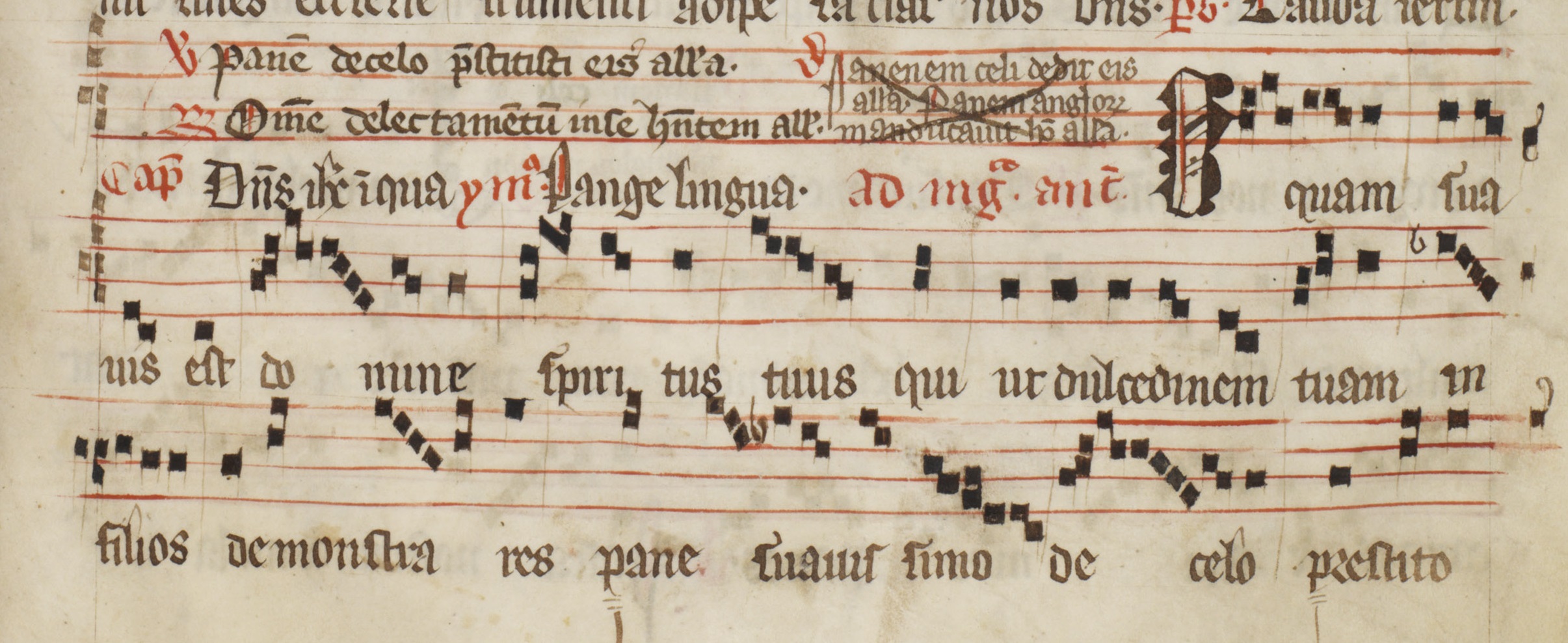A Novice's Guide to the Antiphoner
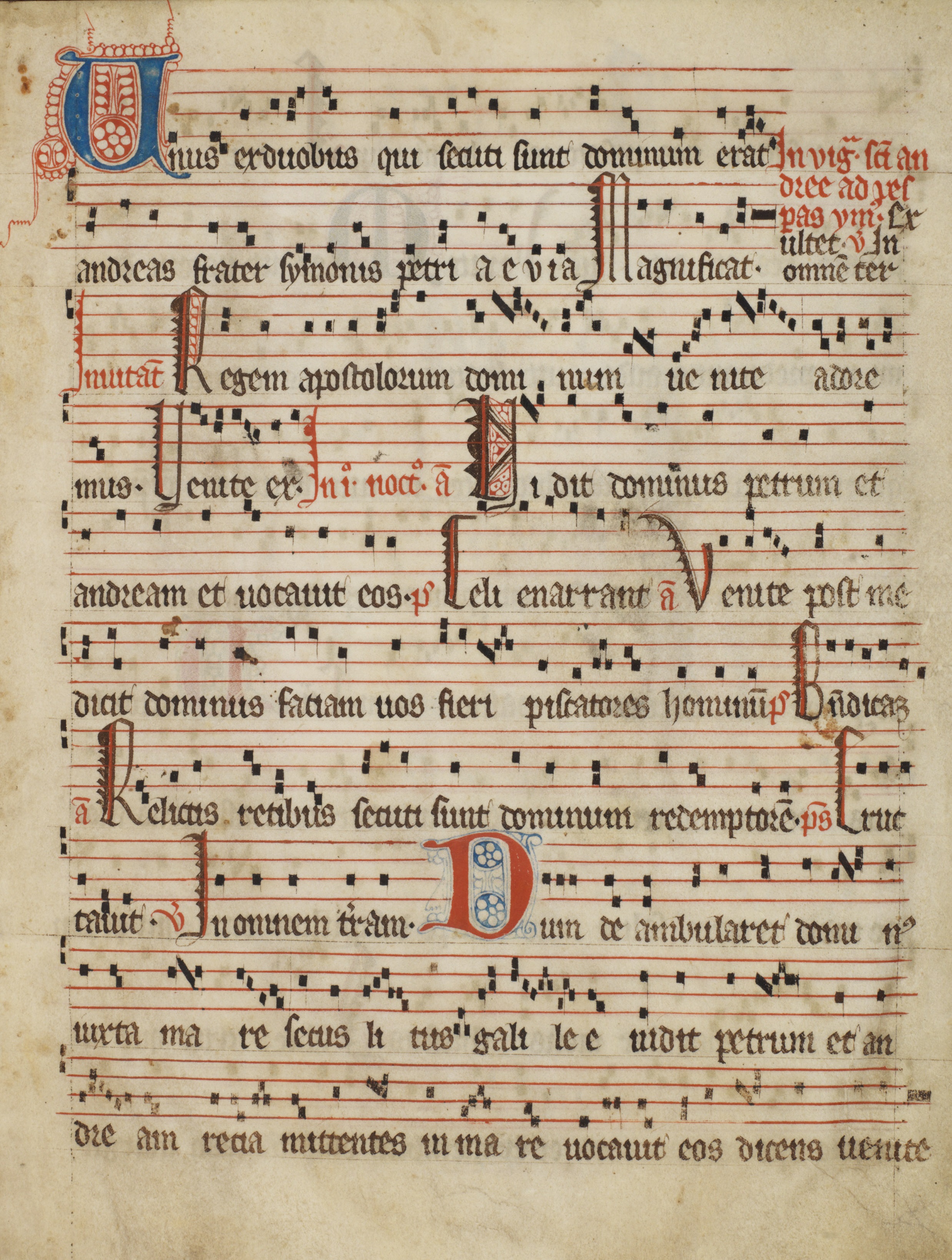
This fourteenth-century manuscript antiphoner (from the Latin antiphonale, or antiphonarium, a book of antiphons) is a volume of monophonic chant—plainsong, or plainchant—used by male or female religious personnel for singing the divine office of the Roman Catholic church. In this instance, the book was almost certainly compiled for, and used by, members of the Franciscan (or Clarissan) order during the 1300s. The book contains the complete words and music for two genres of variable chants—antiphons and responsories—for the offices of the entire annual calendar of saints’ days (sanctorale), as well as text-only incipits or cues indicating other items to be sung, notably hymns (with metrical rhyming texts), and other items that were sung to simple melodic formulas (tones), such as versicles, psalms, and canticles (usually extracts from the bible or other scriptures). As such, this volume originally complemented several other words-only books, including one containing the complete texts of the necessary psalms and canticles (psalterium). Another book also contained the words of the antiphons and responsories (without musical notation), and also the words of chapters and lessons (biblical, patristic and hagiographic pericopes) and prayers, which were also sung to simple formulaic tones. The Franciscans—members of the Order of Friars Minor, founded by St. Francis—were the first to make and use the type of book described as a breviary (breviarium). When pope Honorius III (Cencio Savelli) approved the order’s revised rule in 1223, it specifically directed:
“The clerics will celebrate the divine office according to the order of the holy Roman church,
except for the psalter which they may say in a shortened version” (Clerici faciant divinum officiorum
secundum ordinem sanctae Romanae Ecclesia excepto Psalterio, ex quo habere poterunt breviaria).
In other words, Franciscan clerics were treated not like monks—who were required to recite the liturgical psalter in its long form, or “monastic cursus”, but like secular clerics, who were only required to follow a shortened version, or “cathedral cursus” (Loewen 2013, 37).
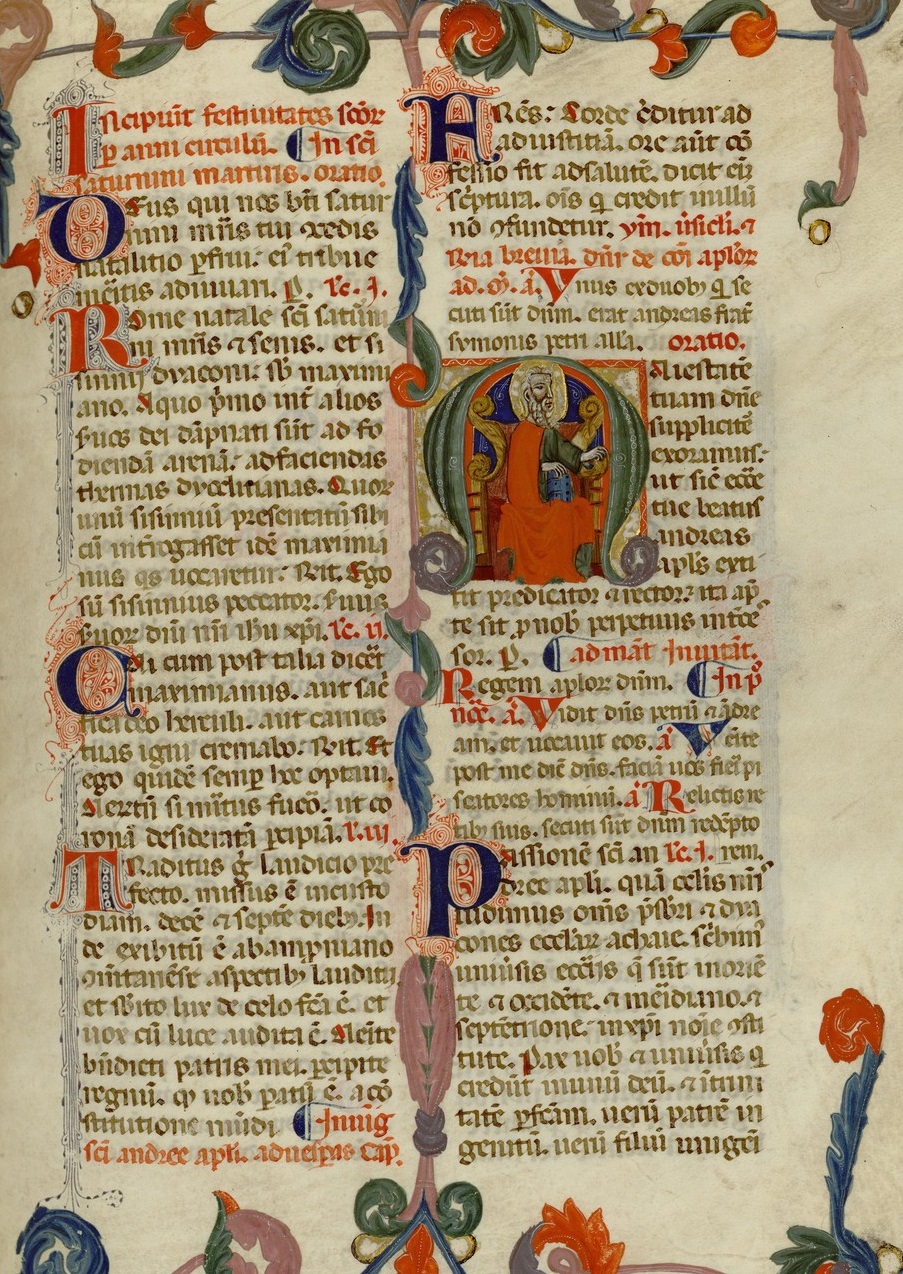
The illustration above is from an Italian Franciscan breviary, also dating from the 1300s, the contents of the page shown corresponding to the first page, fol. 1r, of the John J. Burns Library, Boston College Franciscan antiphoner (henceforth Burns). The words only of the first chant in Burns, the antiphon Unus ex duobus, begin with the red initial “V” (U) on line seven of the second column. But whereas the music and words of this antiphon for the Magnificat is the first chant found in Burns, in the breviary above it is preceded and followed by two other items, the chapter (capitulum), Fratres corde creditor, and the closing prayer (oratio), Majestatem tuam, the first letter of which is sumptuously decorated. Immediately under the prayer are the words of the next four chants in Burns, an incomplete cue for the invitatory at matins, Regem apostolorum, followed by the three antiphons, which in turn are followed by a text not included in the antiphoner, the first lesson, beginning Passionem sancti Andreae apostoli. Reliance on all of these various types of books, the antiphoner included, was in most cases probably mitigated by the individual user’s memory. Religious personnel at this time were typically expected to have key chants of the office by heart, and a relatively small book such as Burns (measuring only approximately 30 centimeters in height) was probably used principally to jog the memories of singers who already knew well the basic melodic contours and features of the chants.
According to custom, there may have also been a companion volume to Burns containing the antiphons and responsories of the parallel annual Sunday cycle of the daily office (temporale), copied around the same time by some of the same scribes. By the late middle ages it had become customary for liturgical chant books arranged in calendar order to begin with the pre-Christmas season. The movable temporal (Sunday) cycle started with the first Sunday in Advent, and the fixed-date sanctorale (saints-day) cycle with the major saint’s day usually closest to it, the feast of St. Andrew (30 November), as is the case in Burns. The services of the daily office hours covered by the contents of Burns are shown in the table below.
| Daily office services (hours) with corresponding antiphons and responsories from Burns | ||
| Service | Time | Chants (italicized when supplied in full in this antiphoner) |
| First vespers | Evening before the saint’s day | 5 psalms with 5 antiphons (not always written out separately in Burns, in which case usually the same as those of Lauds) Magnificat with antiphon |
| Matins | Night or very early in the morning of the saint’s day | Psalm (Venite)
with invitatory (antiphon) First nocturne 3 psalms with 3 antiphons, and 3 responsories Second nocturne 3 psalms with 3 antiphons, and 3 responsories Third nocturne 3 psalms with 3 antiphons, and 2 or 3 responsories |
| Lauds | Immediately after matins | 5 psalms with 5 antiphons Benedictus with antiphon |
| Terce | Morning | A short responsory |
| Sext | Midday | A short responsory |
| None | Afternoon | A short responsory |
| Second vespers | Evening | 5 psalms with 5 antiphons (usually repeats the 5 antiphons of vespers 1 and/or lauds) Magnificat with antiphon |
No special antiphons or responsories were required for the hours of prime (sung after lauds) and compline (after vespers I and 2), so neither of these hours is referred to in the book. Each of the antiphons included was sung before and after one of the 150 psalms or 2 main office canticles (Magnificat at vespers, and Benedictus at lauds), the full words and music for which are also not included in this book. The words are, however, indicated by rubrics or verbal cues (incipits), all that was necessary since most clerics were expected to know the complete psalms and canticles by heart. The music of the psalms and canticles was indicated, meanwhile, by a short melodic formula, or differentia. From the differentia, singers would know immediately which of the 8 modes or tones each verse of the psalm or canticle would be sung to and the particular variable ending to be used.
For further practical information on reading, performing from, and studying the antiphoner, see Harper 1991, Hiley 2009, and Fassler 2014.
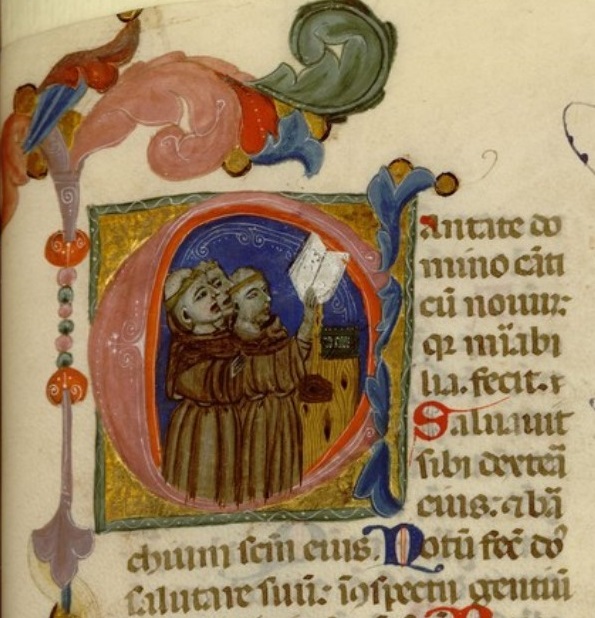
The most recent proper office in Burns, that of Clare, helps date the copying of the book to no earlier than 1300, and probably somewhat later in the century. With a few other exceptions, however, the origins of most of the rest of the chants in the book can be traced back to much earlier stages of the so-called “Gregorian” chant tradition.
Having become established in the church in Rome by the early part of the eighth century, in the latter 700s this chant repertory was exported—text and music—by Roman cantors and sent to northern Europe, where the emperor Charlemagne promulgated it for use throughout his Frankish dominions (Hiley 1993, 514-18). Chant melodies had then still to be memorized and transmitted orally, but by the mid 900s they began to be copied into written musical notation. One of the earliest surviving notated office antiphoners, now preserved as CH-SGs 390 and CH-SGs 391, was copied by the monk Hartker (d.1011), very late in the tenth century (probably in the 990s), for the abbey of St. Gallen in Switzerland (Hiley 1993, 572). Though Hartker’s neumes are described as “unheightened” or adiastematic (that is, they are only partial graphic prompts, and do not alone give all the necessary pitch information to allow a reader who does not already know the chant to sing the melody), the majority of the chants in his book can still now be read by comparing them with later fully-notated sources, such as Burns.
For instance, in the illustration below, the very first chant in Burns, Unus ex duobus, from the office of Andrew, is compared with the much earlier notated version from Hartker’s antiphoner, and the modern printed version of the Liber usualis (1961), all three examples closely similar versions of the same chant. For those not familiar with early neumes, the degree of similarity can be more easily appreciated by comparing the two square-note sources, Burns and the Liber usualis, which can be seen to be nearly, if not quite, identical. Such small differences, however, are common between chant sources.


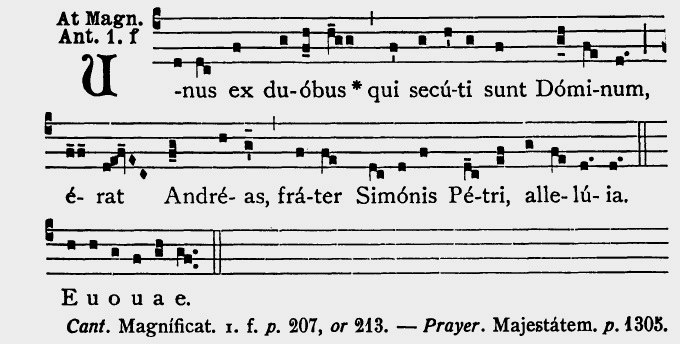
Probably the majority of chants in Burns are of considerable antiquity, though not all the chants of a particular office will necessarily have their origins in the same time or place. In many cases, thematic suitability of a chant text is the only immediately obvious factor to explain its inclusion within a given office. As to the melodies, it is considerably harder to perceive meaningful reasons for why a particular chant was included. In more recent offices, as we shall see, chants were often organized numerically according to mode. But in the relatively ancient office like Andrew there is no such observable pattern. The chants, on casual inspection, appear in a completely haphazard modal order:
| Folio | Office | Genre | Position | Incipit (incipit of subsidiary verse) | Mode |
| 1r | Vespers | Antiphon | Magnificat | Unus ex duobus qui secuti sunt | 1 |
| 1r | Matins | Invitatory | Venite | Regem apostolorum dominum | 3 |
| 1r | Matins | Antiphon | 1 | Vidit dominus Petrum et Andream | 7 |
| 1r | Matins | Antiphon | 2 | Venite post me dicit dominus | 8 |
| 1r | Matins | Antiphon | 3 | Relictis retibus secuti sunt | 2 |
| 1r | Matins | Responsory | 1 | Dum deambularet dominus | 4 |
| 1v | Matins | Responsory | 2 | Mox ut vocem domini | 3 |
| 1v | Matins | Responsory | 3 | Doctor bonus et amicus dei | 3 |
| 2r | Matins | Antiphon | 4 | Dignum sibi dominus computavit | 7 |
| 2r | Matins | Antiphon | 5 | Dilexit Andream dominus in odorem | 8 |
| 2r | Matins | Antiphon | 6 | Biduo vivens pendebat in cruce | 2 |
| 2r | Matins | Responsory | 4 | Homo dei ducebatur | 2 |
| 2v | Matins | Responsory | 5 | O bona crux que decorum | 8 |
| 2v | Matins | Responsory | 6 | Expandi manus meas | 4 |
| 3r | Matins | Antiphon | 7 | Non me permittas domine | 8 |
| 3r | Matins | Antiphon | 8 | Andreas vero rogabat populum | 4 |
| 3r | Matins | Antiphon | 9 | Recipe me ab hominibus | 8 |
| 3r | Matins | Responsory | 7 | Oravit sanctus andreas dum | 8 |
| 3v | Matins | Responsory | 8 | Videns crucem andreas | 2 |
| 3v | Lauds | Antiphon | 1 | Salve crux preciosa suscipe | 7 |
| 3v | Lauds | Antiphon | 2 | Beatus andreas orabat dicens | 8 |
| 3v | Lauds | Antiphon | 3 | Andreas Christi famulus dignus | 8 |
| 4r | Lauds | Antiphon | 4 | Maximilla christo amabilis tulit | 8 |
| 4r | Lauds | Antiphon | 5 | Qui persequebantur iustum | 7 |
| 4r | Lauds | Antiphon | Benedictus | Concede nobis hominem iustum | 7 |
| 4r | Vespers | Antiphon | Magnificat | Cum pervenisset beatus | 1 |
However, even in the table above, a pattern does seem occasionally to emerge. A case in point are the antiphons for lauds, all six of which (along with the psalms and canticle sung with them) belong to the two tetrardus modes, 7 and 8, sharing a common ending on the note G (fol. 3v-4r). Similar cases can be seen in the first five lauds antiphons for Lucy (fol. 5v), and the first five vespers antiphons in the common of apostles (fol. 94v):
| 5r | Lucy | Lauds | Antiphon | 1 | Orante sancta lucia apparuit | 7 |
| 5r | Lucy | Lauds | Antiphon | 2 | Lucia virgo quid a me | 7 |
| 5v | Lucy | Lauds | Antiphon | 3 | Per te lucia virgo civitas | 8 |
| 5v | Lucy | Lauds | Antiphon | 4 | Benedico te pater domini | 8 |
| 5v | Lucy | Lauds | Antiphon | 5 | Soror mea lucia virgo | 8 |
| 94v | Common of apostles | Vespers | Antiphon | 1 | Juravit dominus et non | 8 |
| 94v | Common of apostles | Vespers | Antiphon | 2 | Collocet eum dominus | 8 |
| 94v | Common of apostles | Vespers | Antiphon | 3 | Dirupisti domine vincula mea | 7 |
| 94v | Common of apostles | Vespers | Antiphon | 4 | Euntes ibant et flebant | 8 |
| 94v | Common of apostles | Vespers | Antiphon | 5 | Confortatus est principatus | 7 |
And an example in a different tonality, that of the protus, mode 2, can be seen in four of the first five Vespers antiphons for the office for the dead (80v-81r):
| 80v | For the Dead | Vespers | Antiphon | 1 | Placebo domine | 2 |
| 80v | For the Dead | Vespers | Antiphon | 2 | Heu mihi incolatus | 2 |
| 80v | For the Dead | Vespers | Antiphon | 3 | Dominus custodit te | 2 |
| 80v | For the Dead | Vespers | Antiphon | 4 | Si iniquitates observaveris | 7 |
| 81r | For the Dead | Vespers | Antiphon | 5 | Opera manuum tuarum | 2 |
Different types of pre-planned groupings may be observed in the office of the Purification, where the 9 antiphons of matins are grouped by mode neatly in threes:
| 10r | Purification of Mary | Matins | Antiphon | 1 | Benedicta tu in mulieribus | 4 |
| 10r | Purification of Mary | Matins | Antiphon | 2 | Sicut mirra electa odorem | 4 |
| 10r | Purification of Mary | Matins | Antiphon | 3 | Ante torum huius virginis | 4 |
| 11r | Purification of Mary | Matins | Antiphon | 4 | Specie tua pulchritudine tua | 7 |
| 11r | Purification of Mary | Matins | Antiphon | 5 | Adiuvabit eam deus vultu suo | 7 |
| 11r | Purification of Mary | Matins | Antiphon | 6 | Sicut letantium omnium | 7 |
| 12r | Purification of Mary | Matins | Antiphon | 7 | Gaude maria virgo cunctas | 4 |
| 12r | Purification of Mary | Matins | Antiphon | 8 | Speciosa facta es et suavis | 4 |
| 12r | Purification of Mary | Matins | Antiphon | 9 | Post partum virgo inviolata | 4 |
Such examples of modal organization effectively meant that whole sections of an office were effectively sung in the same tonality, though why this was thought to be desirable in some offices, and not in others, is unclear. But the three most recent offices in Burns—those for Francis, Clare, and Corpus Christi—show unambiguous evidence of a more modern and systematic type of modal pre-planning that was favored by compilers and composers of liturgical chants in the 1200s. The Francis and Clare offices are described more fully below. The following table shows how the principal chants of the office of Corpus Christi are numerically ordered by mode.
| 46r | Vespers | Antiphon | 1 | Sacerdos in aeternum | 1 |
| 46r | Vespers | Antiphon | 2 | Miserator dominus | 2 |
| 46r | Vespers | Antiphon | 3 | Calicem salutaris | 3 |
| 46r | Vespers | Antiphon | 4 | Sicut novella olivarum | 4 |
| 46r | Vespers | Antiphon | 5 | Qui pacem | 5 |
| 46r | Vespers | Antiphon | Magnificat | O quam suavis es | 6 |
| 46v | Matins | Antiphon | 1 | Fructum salutiferum gustandum | 1 |
| 46v | Matins | Antiphon | 2 | A fructu frumenti et vini | 2 |
| 46v | Matins | Antiphon | 3 | Communione calicis quo deus | 3 |
| 46v | Matins | Responsory | 1 | Immolabit haedum multitude | 1 |
| 47r | Matins | Responsory | 2 | Comedetis carnes | 2 |
| 47r | Matins | Responsory | 3 | Respexit Elias ad caput suum | 3 |
| 47v | Matins | Antiphon | 4 | Memor sit dominus sacrificii | 4 |
| 47v | Matins | Antiphon | 5 | Paratur nobis mensa domini | 5 |
| 47v | Matins | Antiphon | 6 | In voce exsultationis | 6 |
| 47v | Matins | Responsory | 4 | Panis quem ego dabo caro mea | 4 |
| 47v | Matins | Responsory | 5 | Cenantibus illis accepit | 5 |
| 48r | Matins | Responsory | 6 | Accepit Jesus calicem | 6 |
| 48r | Matins | Antiphon | 7 | Introibo ad altare dei | 7 |
| 48r | Matins | Antiphon | 8 | Cibavit nos dominus ex adipe | 8 |
| 48r | Matins | Antiphon | 9 | Ex altari tuo domine Christum | 6 |
| 48r | Matins | Responsory | 7 | Qui manducat meam carnem | 7 |
| 48v | Matins | Responsory | 8 | Misit me pater vivens et ego | 8 |
| 48v | Matins | Responsory | 9 | Unus panis et unum corpus | 1 |
| 49r | Lauds | Antiphon | 1 | Sapientia aedificavit sibi | 1 |
| 49r | Lauds | Antiphon | 2 | Angelorum esca nutrivisti | 2 |
| 49r | Lauds | Antiphon | 3 | Pinguis est panis Christi et | 3 |
| 49r | Lauds | Antiphon | 4 | Sacerdotes sancti incensum | 4 |
| 49r | Lauds | Antiphon | 5 | Vincenti dabo manna | 5 |
| 49r | Lauds | Antiphon | Benedictus | Ego sum panis vivuse | 1 |
| 49v | Vespers 2 | Antiphon | Magnificat | O sacrum convivium | 5 |
In this case, however, the melodies were not newly composed in modal order, but were adapted from pre-existing chants. An important early manuscript of the office (Paris, Bibliothèque Nationale de France, Lat. 1143) identifies the original chant from which each melody was borrowed (transcribed by Walters et al. 2006, 83-85). For instance, the manuscript tells us that the first antiphon of vespers, Sacerdos in aeternum, was made “Contra gloria tibi trinitas de trinitate”; that is, it was modelled on the antiphon Gloria tibi trinitas for the feast of the Trinity, as can be seen in the illustrations below. Likewise, the antiphon for the Magnificat at first vespers was also made by setting new words, O quam suavis, to the pre-existing melody of the antiphon O Christe pietas for St. Nicholas (“Contra o christe pietas de sco nicholao”). In the examples below, the two Corpus Christi antiphons as they appear in the Franciscan book, Burns, are compared with the source antiphons as they appear in the Poissy antiphonal, a French Dominican book also dating from the 1300s (Stinson 1993).


